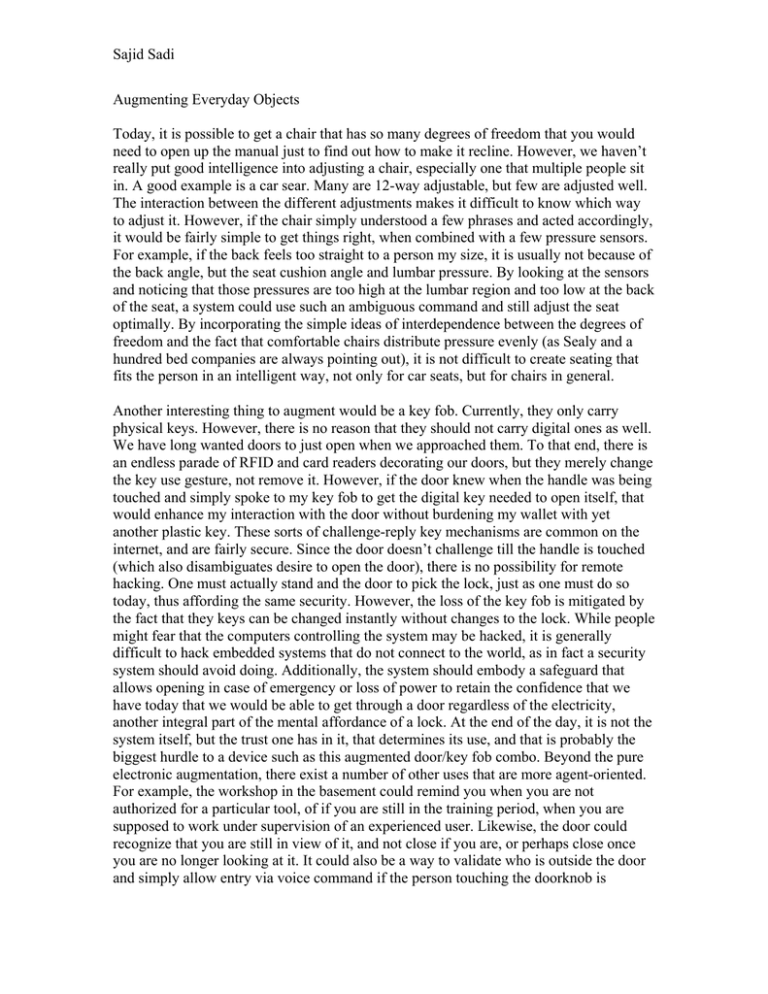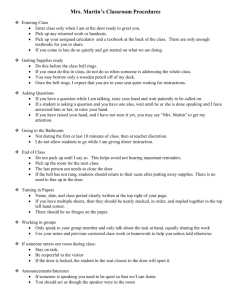Sajid Sadi Augmenting Everyday Objects
advertisement

Sajid Sadi Augmenting Everyday Objects Today, it is possible to get a chair that has so many degrees of freedom that you would need to open up the manual just to find out how to make it recline. However, we haven’t really put good intelligence into adjusting a chair, especially one that multiple people sit in. A good example is a car sear. Many are 12-way adjustable, but few are adjusted well. The interaction between the different adjustments makes it difficult to know which way to adjust it. However, if the chair simply understood a few phrases and acted accordingly, it would be fairly simple to get things right, when combined with a few pressure sensors. For example, if the back feels too straight to a person my size, it is usually not because of the back angle, but the seat cushion angle and lumbar pressure. By looking at the sensors and noticing that those pressures are too high at the lumbar region and too low at the back of the seat, a system could use such an ambiguous command and still adjust the seat optimally. By incorporating the simple ideas of interdependence between the degrees of freedom and the fact that comfortable chairs distribute pressure evenly (as Sealy and a hundred bed companies are always pointing out), it is not difficult to create seating that fits the person in an intelligent way, not only for car seats, but for chairs in general. Another interesting thing to augment would be a key fob. Currently, they only carry physical keys. However, there is no reason that they should not carry digital ones as well. We have long wanted doors to just open when we approached them. To that end, there is an endless parade of RFID and card readers decorating our doors, but they merely change the key use gesture, not remove it. However, if the door knew when the handle was being touched and simply spoke to my key fob to get the digital key needed to open itself, that would enhance my interaction with the door without burdening my wallet with yet another plastic key. These sorts of challenge-reply key mechanisms are common on the internet, and are fairly secure. Since the door doesn’t challenge till the handle is touched (which also disambiguates desire to open the door), there is no possibility for remote hacking. One must actually stand and the door to pick the lock, just as one must do so today, thus affording the same security. However, the loss of the key fob is mitigated by the fact that they keys can be changed instantly without changes to the lock. While people might fear that the computers controlling the system may be hacked, it is generally difficult to hack embedded systems that do not connect to the world, as in fact a security system should avoid doing. Additionally, the system should embody a safeguard that allows opening in case of emergency or loss of power to retain the confidence that we have today that we would be able to get through a door regardless of the electricity, another integral part of the mental affordance of a lock. At the end of the day, it is not the system itself, but the trust one has in it, that determines its use, and that is probably the biggest hurdle to a device such as this augmented door/key fob combo. Beyond the pure electronic augmentation, there exist a number of other uses that are more agent-oriented. For example, the workshop in the basement could remind you when you are not authorized for a particular tool, of if you are still in the training period, when you are supposed to work under supervision of an experienced user. Likewise, the door could recognize that you are still in view of it, and not close if you are, or perhaps close once you are no longer looking at it. It could also be a way to validate who is outside the door and simply allow entry via voice command if the person touching the doorknob is Sajid Sadi trustworthy. This would be a case of the door recognizing the person, but requiring confirmation due to courtesy and social issues. --------------------------------------------------------------------------------





